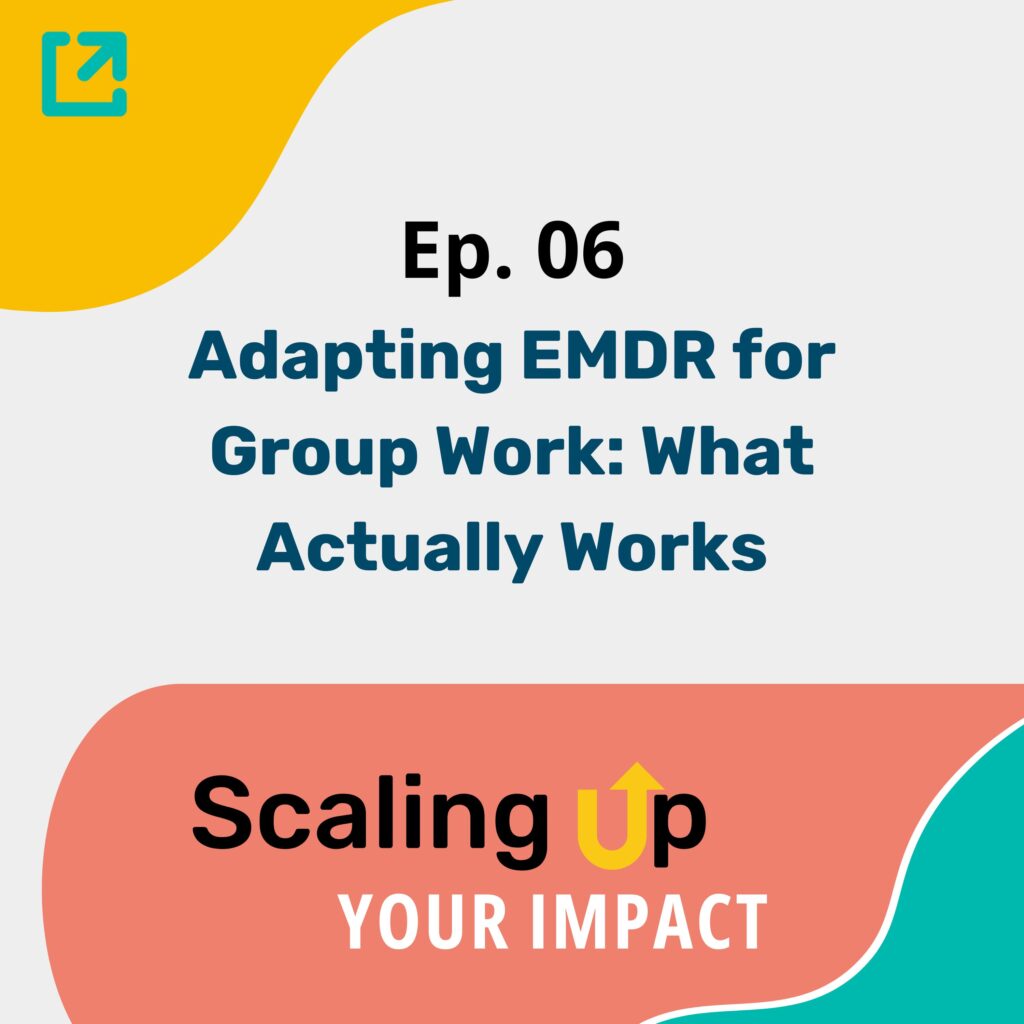Show Notes
Take your group work to the next level with the EMDR GAP Training – scalingupemdr.com/gap-training
Transcript
Hi there, and welcome back to Scaling Up Your Impact—the podcast for trauma-informed therapists who want to expand their skills, confidence, and reach—without burning out.
I’m Kelly Smyth-Dent, founder of Scaling Up, and today we’re diving into a question we get all the time: How can you adapt EMDR for group work?
If you’ve ever wondered whether EMDR can be done outside of individual sessions—or you’ve been curious about group protocols like EMDR-IGTP and G-TEP, this episode is for you.
Let’s start with the why.
The reality is, not every community, agency, or client population has access to weekly, one-on-one EMDR therapy. Whether you’re responding to a community crisis, working in schools, recovery centers, serving displaced populations, or managing long waitlists at a nonprofit—the need for scalable trauma care is huge.
That’s where EMDR-based group protocols come in.
These protocols allow clinicians to bring the healing power of EMDR to more people at once—while still staying rooted in the Adaptive Information Processing (AIP) model and maintaining client safety.
Group EMDR won’t replace individual reprocessing work for everyone—but it can be a powerful tool for:
✅ Stabilization
✅ Symptom reduction
✅ Processing specific events
✅ Reducing distress following recent or ongoing trauma
And for many clients, it’s an accessible, low-barrier way to engage in EMDR.
So… what actually works when adapting EMDR for groups?
Let’s talk about two widely used and well-researched protocols:
First, there’s G-TEP: The Group Traumatic Episode Protocol
- G-TEP was designed as an early intervention protocol for groups affected by a shared traumatic event.
- It uses a worksheet-based, visual format where each participant follows along at their own pace—privately focusing on their experience without having to share verbally.
- G-TEP is often used in humanitarian and local settings.
- It’s structured, contained, and helps reduce distress tied to recent trauma exposure.
Our go-to protocol is the EMDR-Integrative Group Treatment Protocol—or EMDR-IGTP
- This protocol is part of our EMDR GAP Training. It was the first EMDR group protocol to be created. It is part of a stepped-care approach to mental health, along with the other interventions taught in the EMDR GAP Training. These protocols are the most researched in the early intervention and ongoing traumatic stress fields with over 90 peer-reviewed articles.
- The EMDR-IGTP is especially helpful when working with clients experiencing ongoing traumatic stress, such as conflict-affected populations, marginalized groups, or communities with chronic exposure to violence or instability.
- It is highly effective in treating clients in the aftermath of climate or human-made disasters, wars, and large scale adverse events.
- Clients navigating highly contentious divorces, family loss, medical diagnoses, sexual abuse, and domestic violence also benefit from the EMDR-IGTP
- Like G-TEP, EMDR-IGTP is also non-verbal and uses visual elements, including something called the Butterfly Hug (created by Lucy Artigas) for bilateral stimulation.
- What makes EMDR-IGTP unique is that it’s designed to be delivered across multiple sessions in an intensive format, giving clients the space to build trust in the process, strengthen their resilience, and gradually move into deeper levels of processing at a pace that feels safe.
Both G-TEP and EMDR-IGTP are supported by research and widely used internationally. And both can be delivered in-person or adapted for online settings, with thoughtful planning.
While these protocols are effective, there are important considerations before jumping into group EMDR work.
Here’s what makes group EMDR effective:
✅ Clear, scripted protocols designed specifically for groups
✅ A focus on safety, containment, and stabilization
✅ Adequately trained therapist and support facilitators skilled in group treatment
✅ Non-verbal formats that protect client privacy
✅ Targeting of the same type adverse events experienced by all participants (ie: divorce, wildfire)
✅ Keeping the group structure predictable and time-limited
And here’s where you should pause and think critically:
- Group EMDR is not appropriate for every client—especially those with severe dissociation, complex PTSD, or significant instability.
- You’ll want to assess group members carefully beforehand.
- And you’ll need to have a clear post-group support plan in place—for referrals, follow-up, and individual care if needed.
At Scaling Up, we’re passionate about helping therapists not just deliver EMDR—but deliver it ethically and effectively—even in non-traditional formats like groups.
If you’re feeling curious about bringing EMDR into group settings—or if you’re already serving high-need communities and wondering how to make trauma care more scalable—our EMDR GAP Training is a great next step.
The EMDR GAP Training is often touted by participants as “the essential Part 3 of Basic Training!” It includes hands-on guidance on how to use the EMDR-IGTP, alongside other protocols tailored for clients facing the three most common trauma scenarios: recent events, current ongoing trauma, and past prolonged adverse experiences.
The EMDR GAP Training is EMDRIA-approved, and designed for therapists who are already EMDR-trained but want to build capacity for group, acute and prolonged trauma work in clinical, community and humanitarian settings.
You can learn more about GAP and register at scalingupemdr.com/gap-training.
And of course—if you’re interested in G-TEP or other EMDR group protocols, we always encourage additional training and consultation to ensure you’re delivering these models safely and skillfully.
Thanks so much for tuning in today. Whether you’re working one-on-one, in groups, or somewhere in between, your work matters—and we’re here to support you every step of the way.
For more trainings, resources, and community connection, head over to scalingupemdr.com.
Until next time—keep scaling up your impact.



